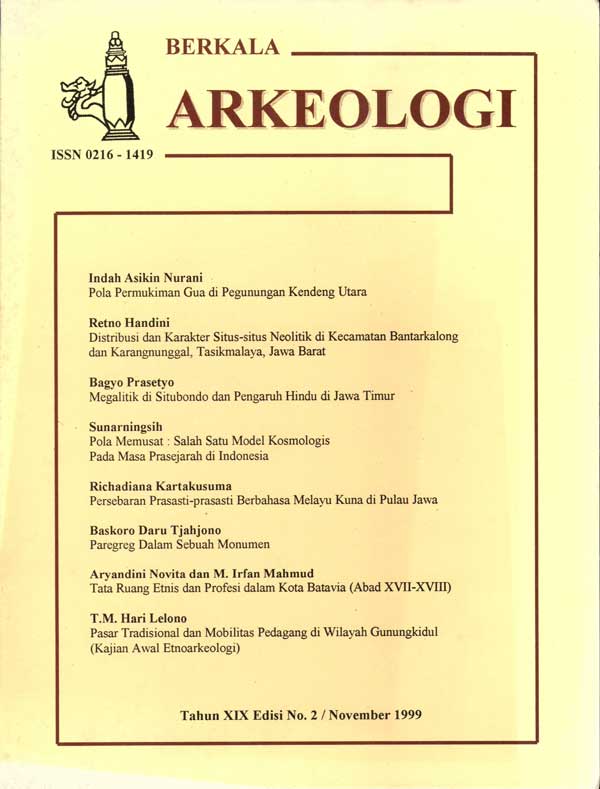MEGALITIK DI SITUBONDO DAN PENGARUH HINDU DI JAWA TIMUR
Main Article Content
Abstract
Based on the chronology of the development of megalithic culture in Situbondo, it can be seen that at least around the 5th century (according to carbon dating) there was even a long time before, that the megalithic tradition had taken root and continued to develop much later until the 15th century AD or maybe more after the collapse of the kingdom with Hinduism characteristics (Majapahit) in the East Java region. Megaliths as a tradition and the original belief of the Indonesian people do not seem to be easily shifted by external (foreign) religious influences. In general, the influence of foreign religions is only attached to the community within the palace or society that is included in the reach of the reins of government, while those outside are not affected by these elements. If you pay close attention, it seems that the people who support the megalithic tradition always build a fairly broad community.
Article Details

This work is licensed under a Creative Commons Attribution-NonCommercial-ShareAlike 4.0 International License.
References
Bagyo Prasetyo dan Retno Handini, 1999. Survei Keruangan Situs-situs Megalitik di Kabupaten Situbondo, Provinsi Jawa Timur, dalam Laporan Penelitian Arkeologi Bidang Prasejarah Tahun 1999. Jakarta: Puslit Arkenas, belum terbit.
Badan Pusat Statistik dan Bappeda Kabupaten Situbondo, 1998. Situbondo dalam Angka 1998. Situbondo: Badan Pusat Statistik Situbondo.
Brandes, J.L.A. 1913. Oud Javaansche Oorkonde, Nagelaten transcripties van wijlen Dr. J.L. Brandes, uitgegeven door N.J. Krom, VBG LX.
Geldern, Robert von Heine, 1945. Prehistoric Research in the Netherlands Indies, dalam Ppeter Honig dan Frans Verdoorn (ed), Science and Scientist in the Netherlands Indies. New York: Board for Netherlands Indies, Surinam and Curacao.
Kern, H., 1917. De steen van den berg Penanggungan (Surabaya), thans in 't Indian Museum te Calcutta, dalam Verspreide Geschriften Vil. 's-Gravenhage: Martinus Nijhoff.
Knebel, J., 1906. Beschrijving der Hindoe-Oudheden in de afdeelingen Djember, Banjoewangi, Bandawasa, Sitoebanda, en Besoeki der Residentie Besoeki, dalam ROC 1904, Batavia: Albrecht & Co. Hlm. 135-156.
Pendowo, Budisantoso, 1991. Geologi Lembar Besuki Jawa Timur. Bandung: Pusat Penelitian dan Pengembangan Geologi Departemen Pertambangan dan Energi, Direktorat Jendral Geologi dan Sumberdaya Mineral.
Sekretariat Jendral Biro Data dan Analisa, 1981. Potensi dan Sarana Penunjang Pengembangan Industri Propinsi Jawa Timur. Jakarta: Departemen Perindustrian.
Sumadio, Bambang (ed.),1984. Sejarah Nasional Indonesia II. Jakarta: Balai Pustaka.

